Minnesota United welcomed Vancouver Whitecaps to Allianz Field as they looked to improve their playoff position in the MLS Western Conference. The Loons have been undefeated in the US Open Cup and league since the 8th June, winning seven of eight matches. An opponent with this run of form was the last thing that the Vancouver Whitecaps needed. They haven’t won a match since a 2-1 victory over FC Dallas at the end of May. The Canadians have the second-worst record in MLS, and this match was an excellent example of why.
The Loons run of form this summer has been more impressive since they’ve done most of it without Romain Metanire, who started for Madagascar during their surprise run to the quarter-finals of this summer’s Africa Cup of Nations. They were able to overcome this absence with a dangerous attack, with Darwin Quintero responsible for two goals and two assists in the previous four matches, while Mason Toye has got a point in his last five appearances.
This matchup looked like it should have been a comfortable victory for Minnesota United, but Vancouver defended well. They struggled to present any threat going forward, but they defended successfully. The away side avoided the type of mistakes and mental lapses that have punished them severely this summer. As Minnesota United had more problems in the attack, they became increasingly reliant on crosses from Romain Metanire at right-back. After 37 crosses, and only one shot on target, this match ended in a 0-0.
Keys to the match
In this tactical analysis, we will examine how Vancouver’s defensive structure allowed them to defend stoutly against a determined attack by the home side. Also, this analysis will look at how Minnesota United stifled Vancouver’s tactics to advance the ball centrally. Finally, we’ll also look at the struggles of Abu Danladi after he came on as a substitute.
Lineup
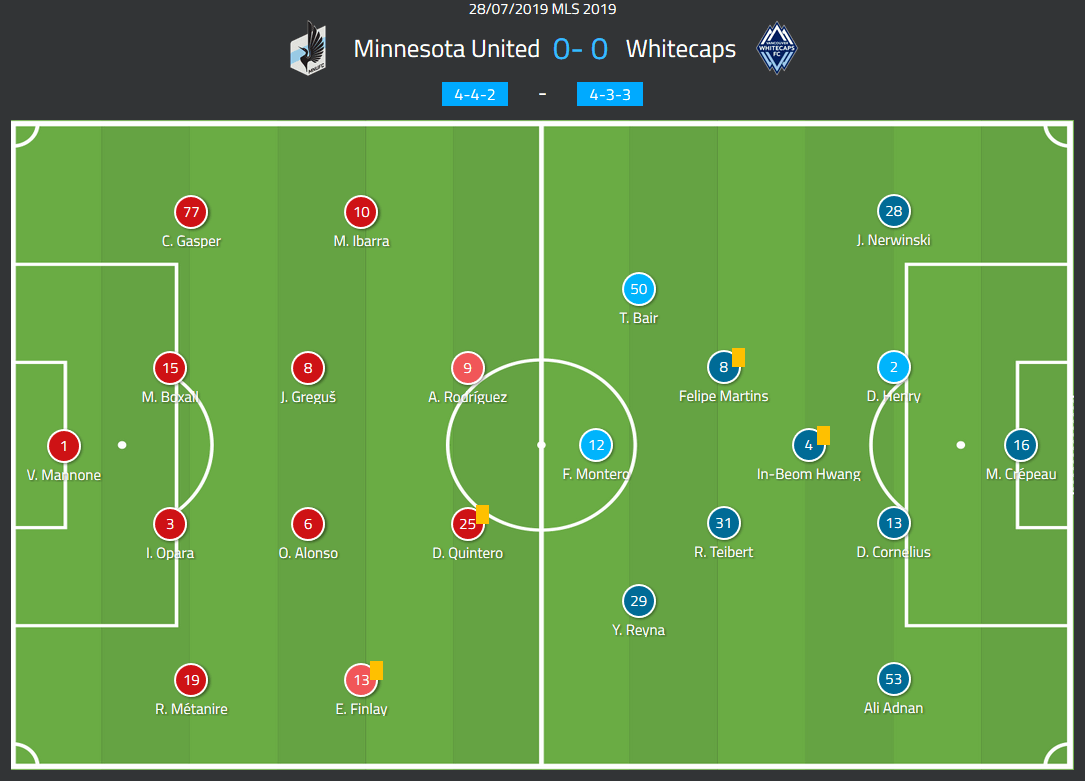
Adrian Heath made two changes from the side that took a point in a 1-1 draw away to Real Salt Lake. Kevin Molino missed this match with a leg injury, replaced by Miguel Ibarra on the right-wing. In the central midfield, Osvaldo Alonso returned to the starting lineup, and Hassani Dotson returned to the bench.
Marc Dos Santos made three changes to the side that got eliminated from the Canadian Championship three days earlier. After a limp 2-1 defeat to Cavalry FC, Eric Godoy and Andrew Rose were dropped to the bench. Lass Bangoura was left out of the matchday squad altogether. Derek Cornelius started at centre-back, giving Godoy a break after playing every minute in the MLS so far this season. Russell Teibert came into the midfield trio, and Fredy Montero returned after getting a break in the midweek match.
Minnesota United over-reliant on crosses
From the starting kick, Vancouver was satisfied to sit deep and defend. This was a dangerous tactic, as their defence has given up 10 goals in their last three league matches. This decision was also puzzling, as Minnesota United is the second highest-scoring team in MLS behind Los Angeles FC, so very few teams have been able to slow down their prolific attack.
Going forward, Vancouver Whitecaps attacked in a 4-3-3, but they dropped into more of a 4-4-2 when out of possession. Left-winger Yordy Reyna would stay forward with Fredy Montero, providing little defensive work and trying to remain available as outlets on the counter-attack. This meant that Russell Teibert, who played on the left side of the three central midfielders, was responsible for shuffling out wide on the left side to assist left-back Ali Adnan defensively. In the images below, we can see Reyna and Montero staying high up the pitch in a central location.
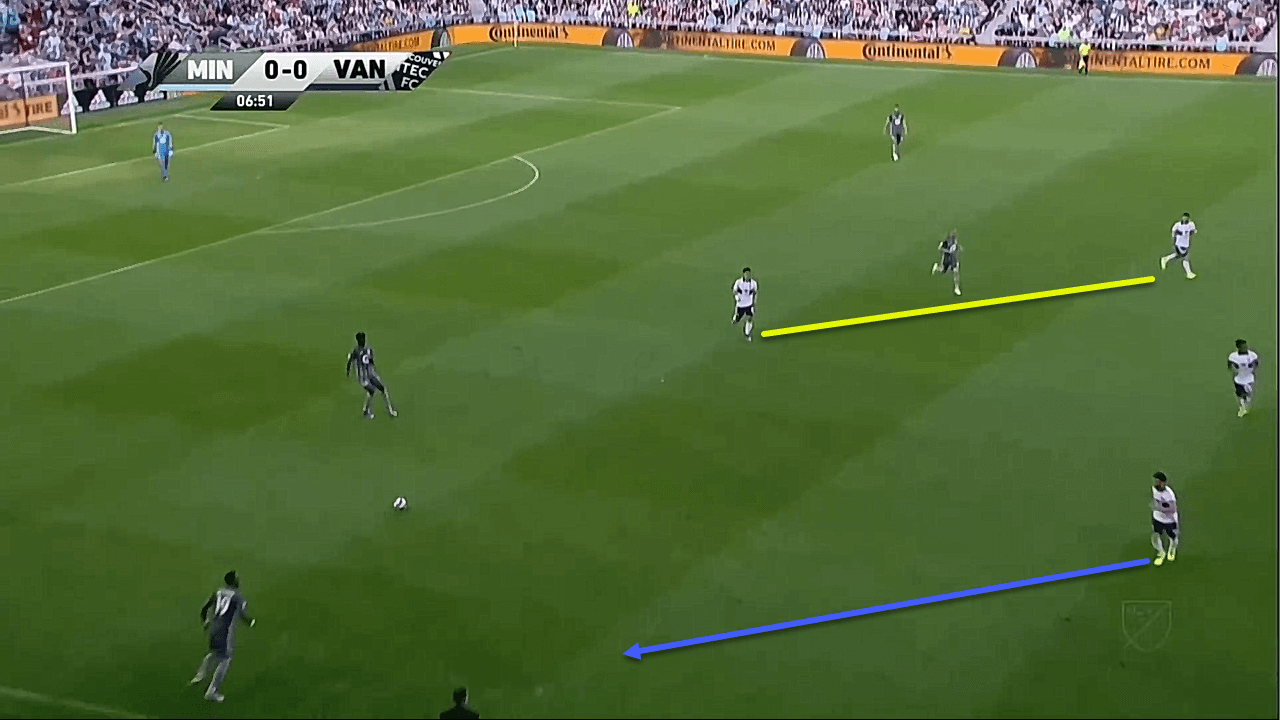
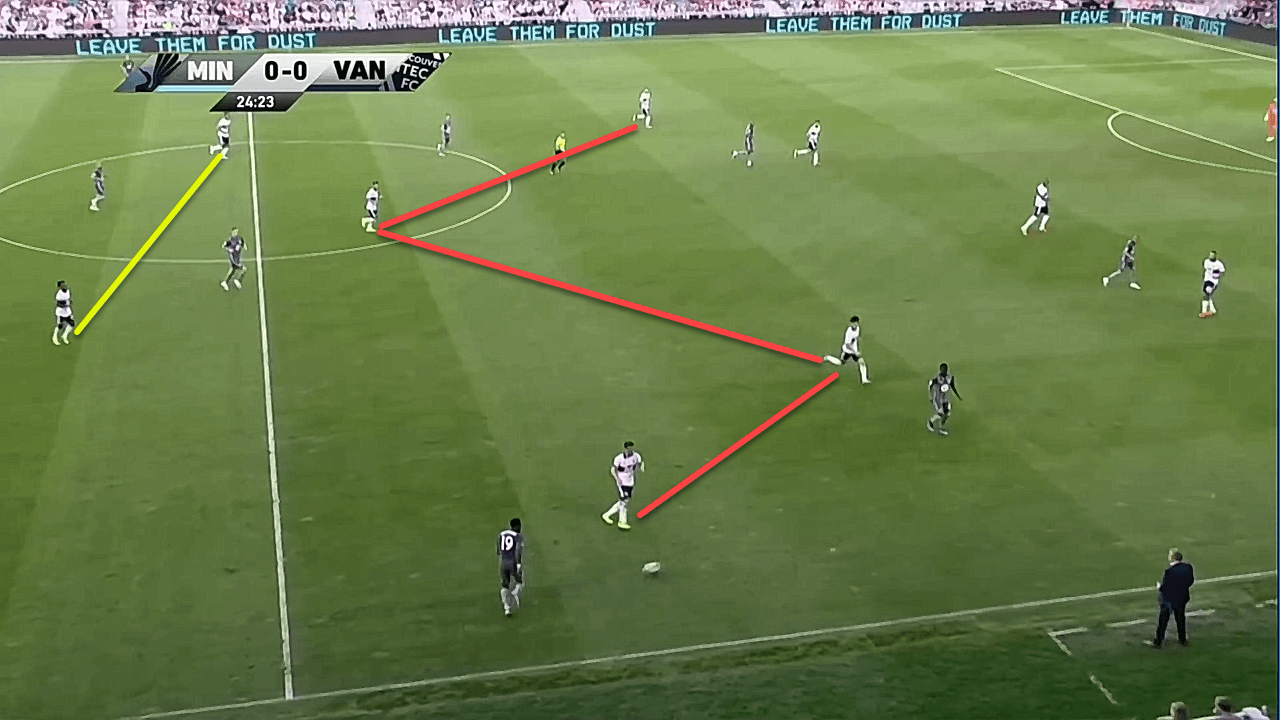
Marc Dos Santos could be seen throughout the first half giving his central midfielders instructions to clog up the middle of the pitch. The Whitecaps were very successful in their plan, but Minnesota United was also complicit in their problems. The home side was too reliant on the crosses coming from Romain Metanire. His ability to deliver crosses is one of the Loons most dangerous attacking avenues, but they were too willing to settle for this option.
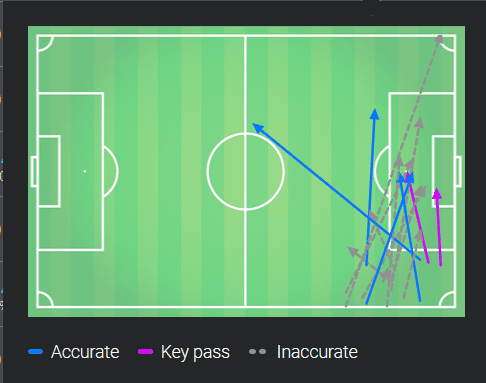
Minnesota United suffered from a lack of presence in the middle of the pitch when they progressed into the final third. Darwin Quintero, who operates close to Angelo Rodriguez, functions as more of a second striker rather than a central attacking midfielder. This is successful on counter-attacks and transitions, but when they have more possession and time in the final third, as they did in this match, this leaves gaps in their structure in central areas outside the box.
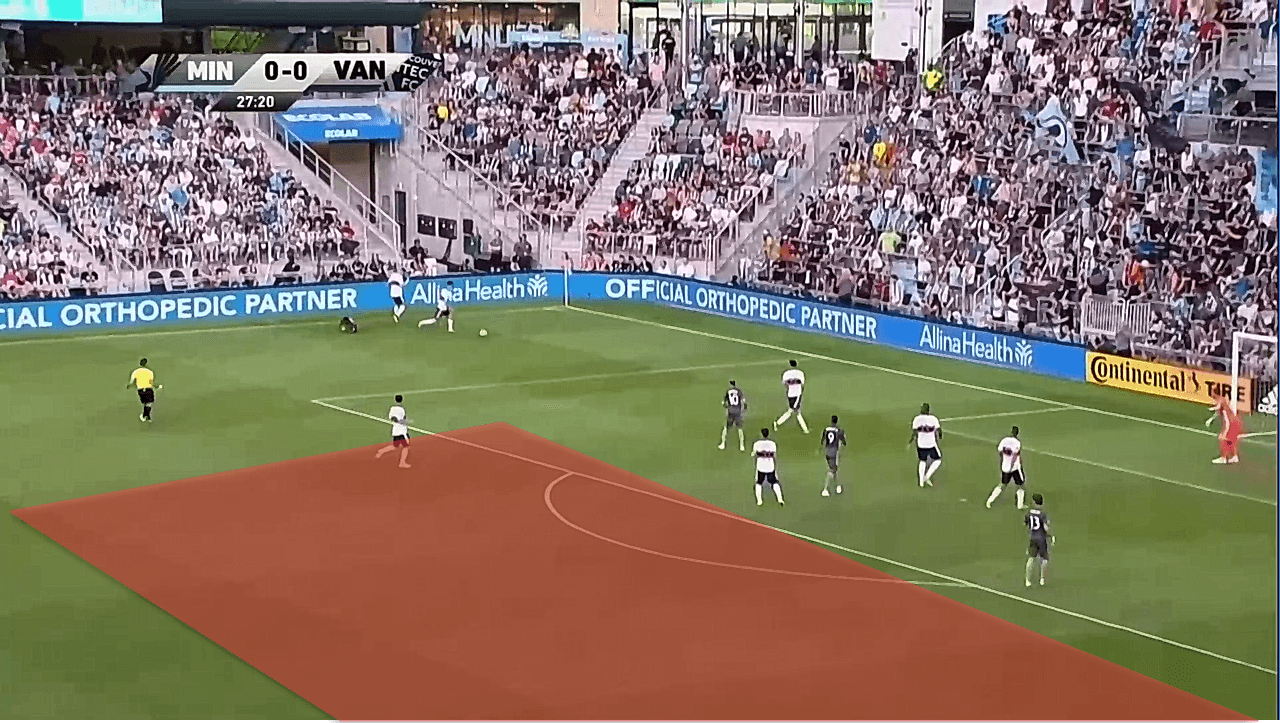
This problem could be solved by late runs from either of the defensive midfielders, Osvaldo Alonso or Jan Gregus, but neither one of these players came forward to operate in this area. We can see in the images below that Darwin is playing a very advanced role, near Rodriguez, but there is nobody operating in the space behind him. This large gap in the central area could easily be filled by Jan Gregus, who is the more attacking option in the double pivot, but he was frequently too deep to support the attack.
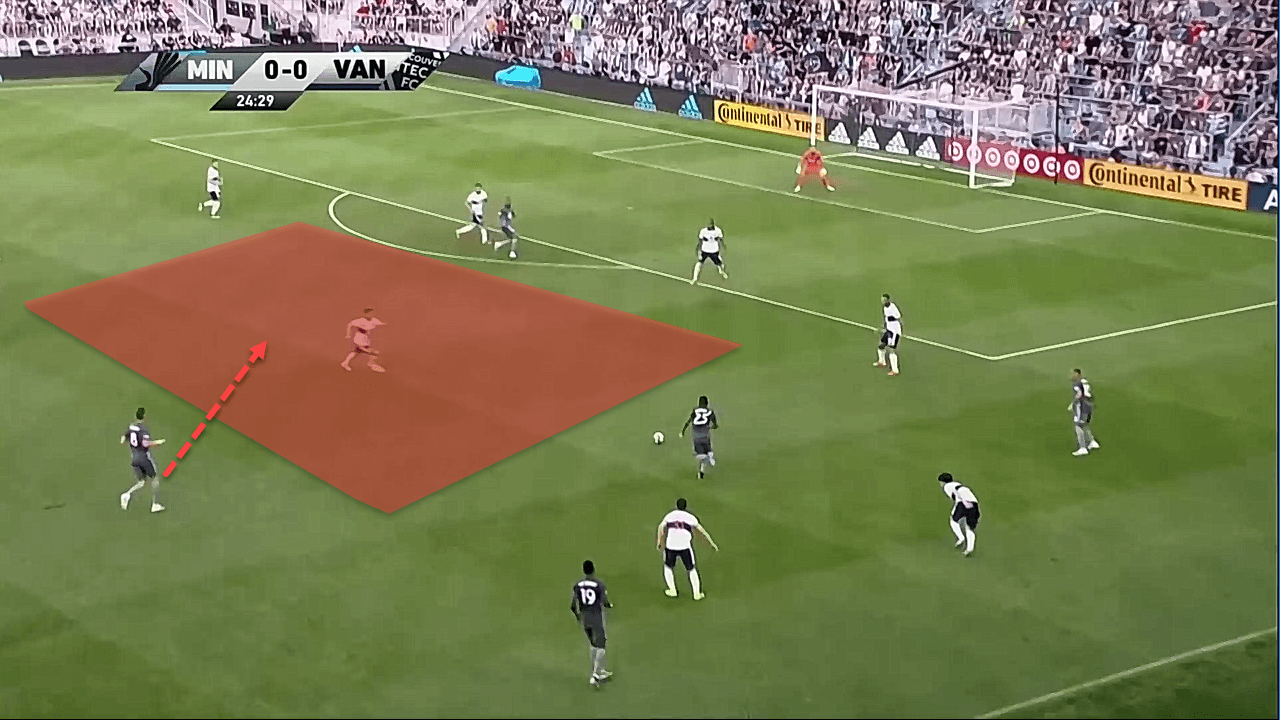
Miguel Ibarra got the start on the left wing, while Ethan Finlay started on the right wing. As the match wore on, and Minnesota United dominated possession, the wingers would frequently switch sides to try and unlock the low block of the Canadians. While Finlay mostly operated in the wide areas, playing as an orthodox winger, Ibarra was much more willing to drift into central locations and attempt to help fill the gaps in the Loons attack structure. In addition, Ibarra did a better job combining with Metanire on the right side.
Ibarra tried to exploit the space in the half-space, and this allowed Metanire the space for overlapping runs. This was frequently not available when Finlay was on the right side, as he would stay near the touchline and the space was too congested. As we can see in the image below, Ibarra has moved into the halfspace and is attacking towards the goal. Metanire can overlap, and then play the ball in front of Ibarra.
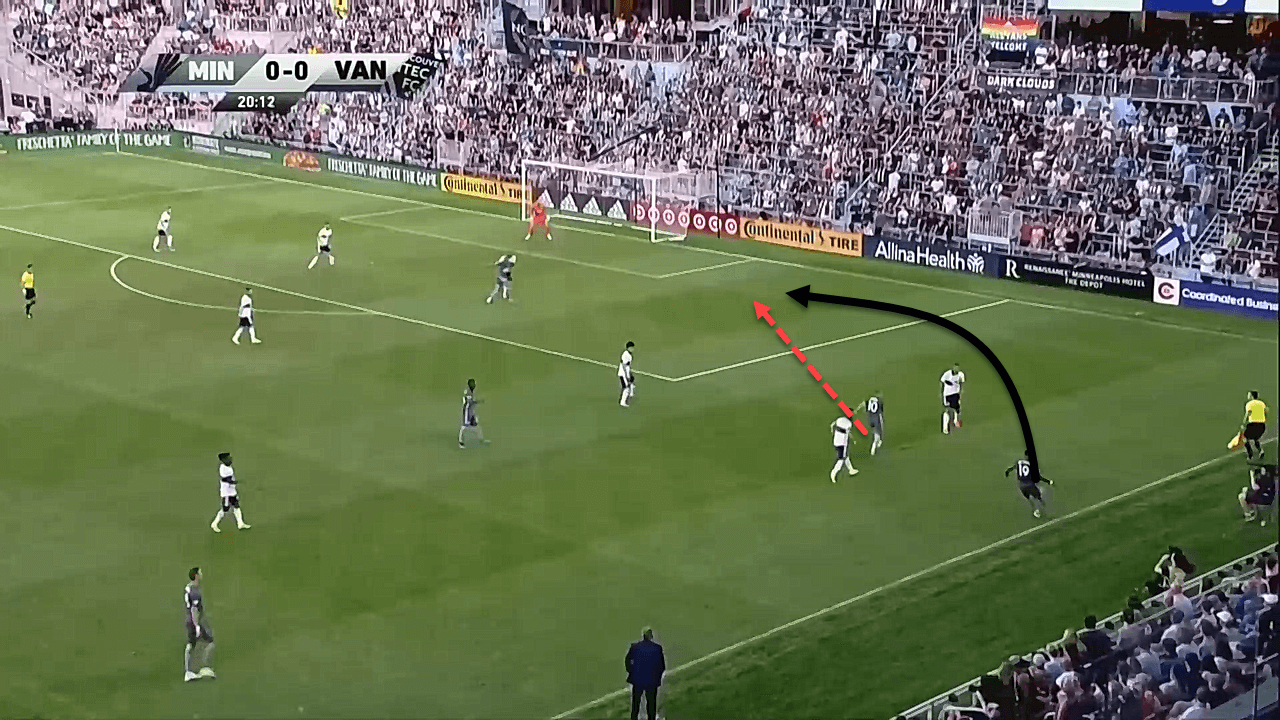
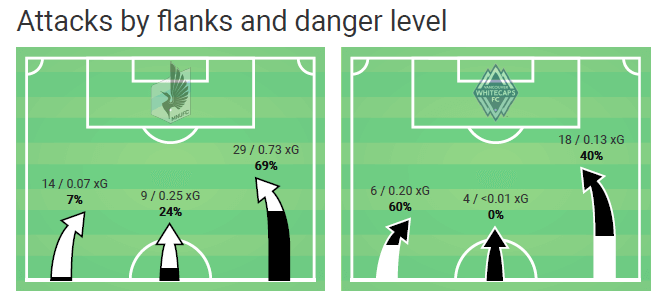
Vancouver unable to progress centrally
The Vancouver Whitecaps did an excellent job defensively, but they had problems transitioning into the attack. Minnesota United’s defence started up front, with Rodriguez and Darwin doing an excellent job in preventing the Whitecaps from playing the ball into the midfield. One of VWFC’s critical players in possession is Inbeom Hwang. He’s been responsible for 1,467 touches coming into this match, including 968 successful passes, but he was unable to get on the ball in this match.
As a result of Darwin and Rodriguez’s work, Vancouver were forced to play the ball out to the full-backs, and they would attempt to play the ball up the touchline to the wingers. This was an inefficient method of progressing the ball, and as a result, Minnesota United were able to pin the Whitecaps in their half of the pitch throughout the first half.
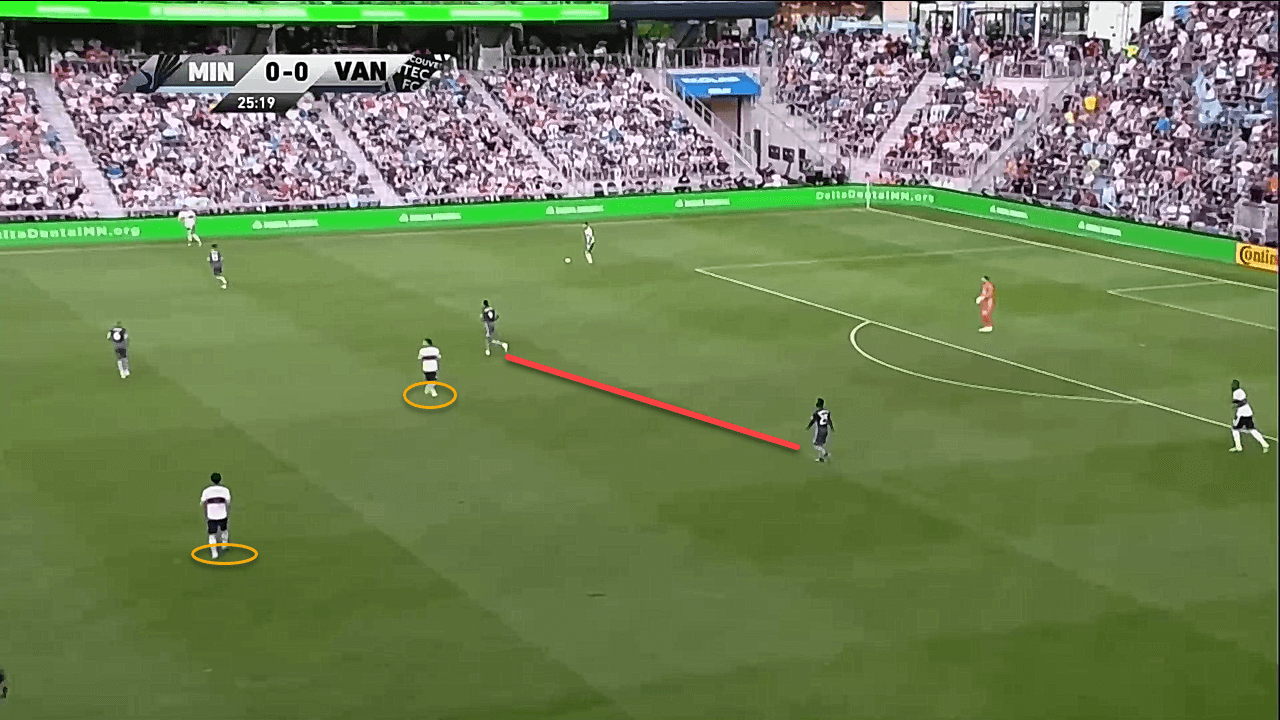
Minnesota United were also more willing to press high up the pitch. The Loons attacking players did a good job in shutting down passing lanes and forcing Vancouver into sterile possession with their centre-backs. Besides, while Gregus was reluctant to advance up the pitch on the attack, he had no such issues defensively. He would frequently come high up the pitch to pressure the opposing midfield, leaving Alonso alone to shield the backline.
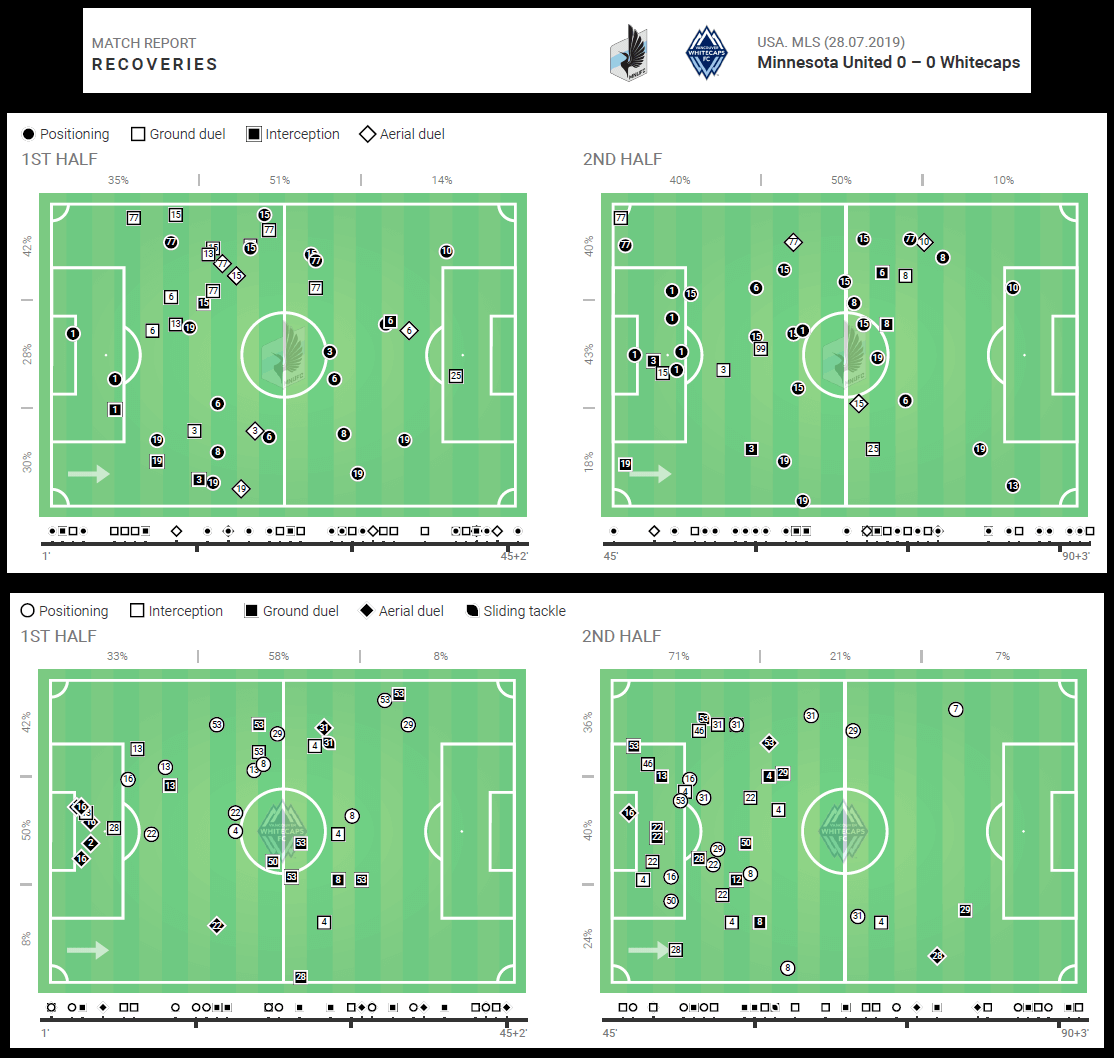
Is Danladi’s time at an end?
With control of possession, but struggling to create changes, Adrian Heath made a double substitution in the 66th minute. He took out Angelo Rodriguez and replaced him with Mason Toye. Toye has been impressive for Minnesota United of late, scoring four goals and two assists in his last five league appearances. Even more impressive, only two of the appearances were starts. This was a straight swap that made sense, as Toye has been productive lately and Rodriguez was tired after logging plenty of minutes in the summer heat.
The second swap in the 66th minute was replacing Ethan Finlay with Abu Danladi. Danladi, the first overall pick in the 2017 MLS Superdraft, has had a stop-start time with the Loons. He’s struggled to stay healthy, and this match was an excellent example of his shortcomings. His pace was dangerous on the right side, but his decision making and final product left a lot to be desired.
In the image below, we can see that Danladi has got ahead of his defender. He gets to the touchline and has two available targets in the penalty area. There are five Vancouver Whitecaps defenders in the box, but Ibarra is the target to pick out at the far post. Instead, Danladi tries to cut the ball back towards the top of the penalty area. Unfortunately for Danladi, he underhit the pass, and there were no late runs following up the attack.
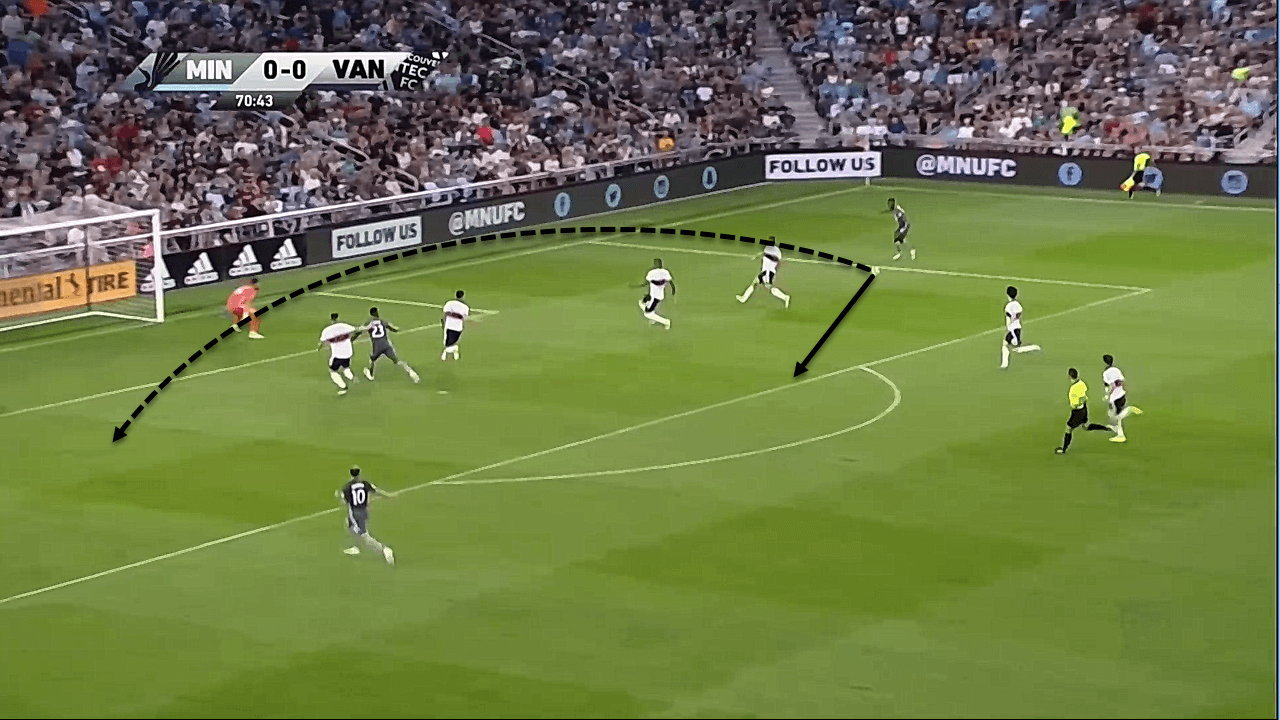
Conclusion
This was the type of match that Minnesota United should have been able to win easily. A victory here would have moved Minnesota United into second place in the Western Conference. Unfortunately for Adrian Heath’s side, his attack struggled against a determined Vancouver defence. The dependence upon Metanire’s crosses played into the Canadians’ defensive structure, but playing with a more attacking option alongside Alonso in the midfield would have caused more problems for Vancouver. While this match was a missed opportunity, a point keeps the Loons in the playoff spots and means they can focus on their upcoming match against the Portland Timbers in the US Open Cup semi-final.
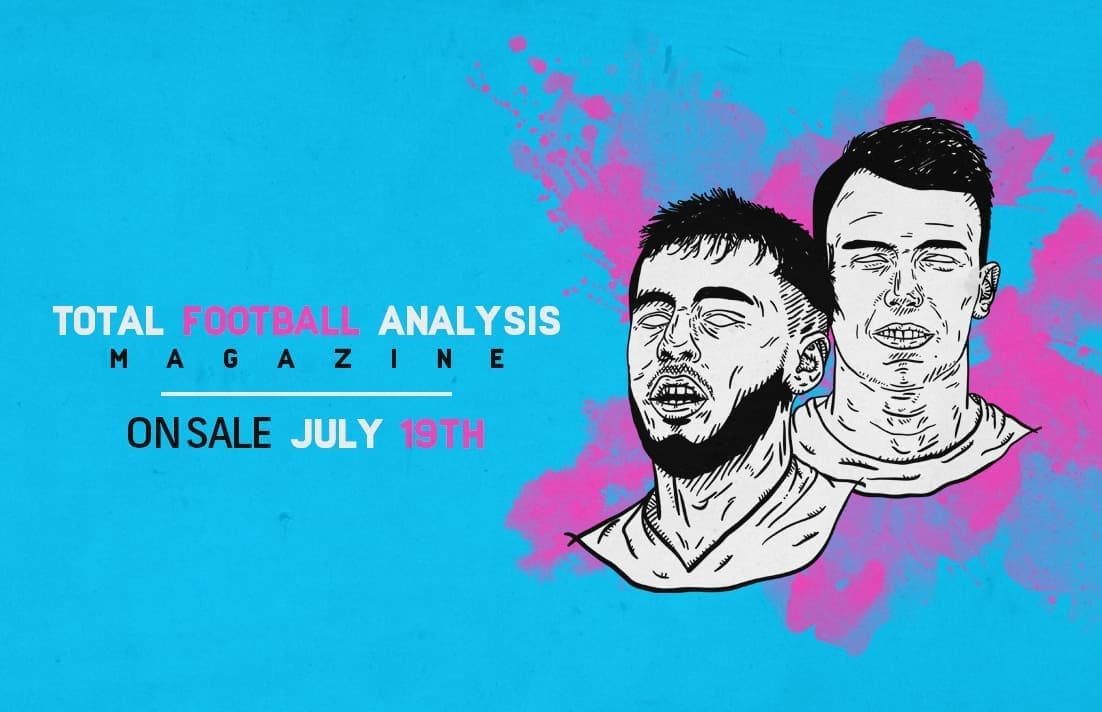
If you love tactical analysis, then you’ll love the digital magazines from totalfootballanalysis.com – a guaranteed 100+ pages of pure tactical analysis covering topics from the Premier League, Serie A, La Liga, Bundesliga and many, many more. Buy your copy of the July issue for just ₤4.99 here, or even better sign up for a ₤50 annual membership (12 monthly issues plus the annual review) right here.

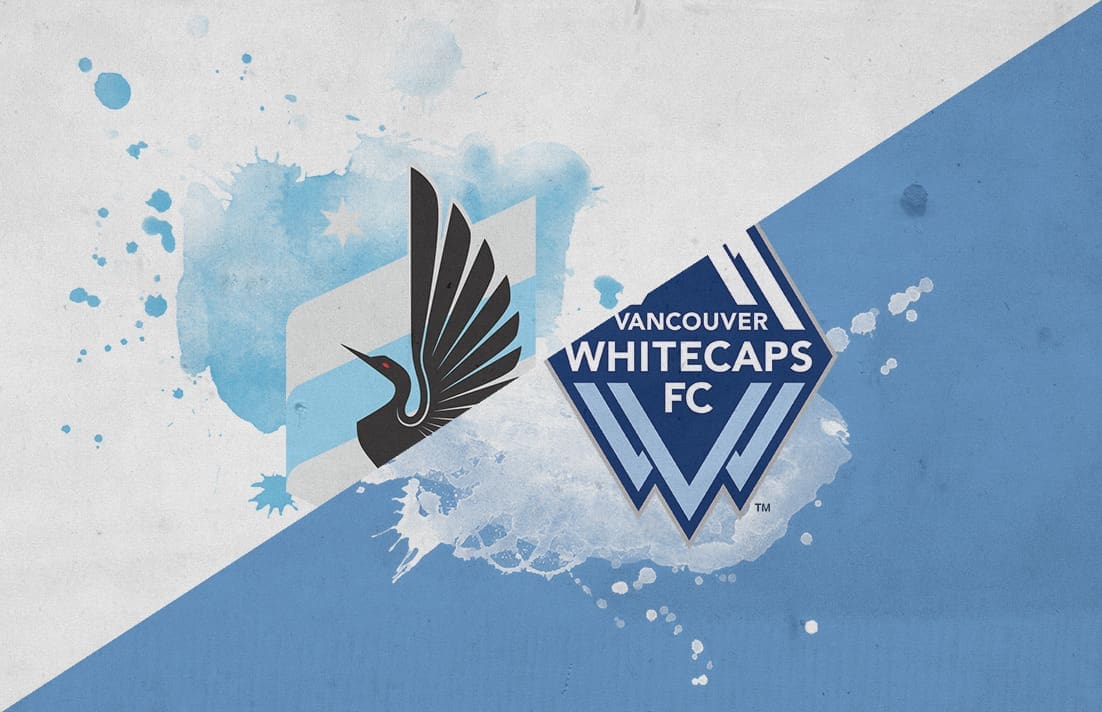



Comments